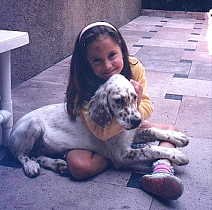


Those of us who
own pets know the obvious responsibility and commitment involved in properly
caring for them. However, children
are often unaware of what it takes to appropriately raise and maintain a pet in
a way that promotes the emotional and physical health of the animal.
There is much to consider before gifting a pet to a child, including the
chronological and emotional age of the child and the level of responsibility the
child has shown previously. Furthermore,
your own willingness to “pick up the slack” if your child’s commitment
falters, and his or her personality characteristics, such as patience,
frustration tolerance, perseverance, and empathy, also will be significant
factors in how successful the family’s new relationship with its pet will be.
Most importantly, the child’s expectations about the pet and what
owning the pet will be like may be the best predictor of a healthy and mutually
rewarding pet relationship.
Children have
powerful fantasies about what having a puppy will be like. Furthermore, the child’s intense desire to have a pet is
partly rooted in a fantasized relationship that does not include feeding,
walking, grooming and training the animal.
It is, most likely, filled with images of romping and cuddling together.
Our expectations have a strong impact on the potential success of most
relationships, and a pet relationship is no different.
A child who understands and appreciates that he or she will have both
ample romping, and ample responsibility, will be more likely to remain
interested and invested in the pet, and get much more out of the relationship.
There are a few
ways that you can expose your child to the reality of having a pet.
A simulation of giving your child something to be responsible for is an
effective technique. I recommend a hard-boiled egg, since it is somewhat fragile,
but will not make a mess if broken. Discuss
the reasoning of the technique with your child in a way that is easily
understood for his or her age level. Include
that it is a way to get used to feeling responsible for something all the time,
and include goals of not cracking the egg or leaving it alone for too long.
Establish rules
that are similar to what a puppy would need.
If your child is interested in a puppy, for instance, have the child take
the egg for a walk multiple times per day and pretend to feed it twice a day.
If you really want to have fun with it, you can go further, as long as
you explain and agree on the rules before the simulation begins.
If the child leaves the egg unwatched for a certain amount of time, pour
a small puddle of water in that area of the home and let your child know that
the puppy “peed again.”
Of course, be
reasonable, and pay careful attention to how your child responds to the
interruptions in his or her day. Keep
this up for a few weeks (replacing smelly eggs). This will offer a fair indicator of your child’s readiness
to care for a pet. If it becomes a
nuisance to you, it will likely feel that way when your child is responsible for
an animal. Keep in mind, also, that
this technique has its flaw, since a pet is far more rewarding than an egg, and
your child will have caring feelings for the pet.
A second
strategy for helping your child develop realistic expectations is to discuss at
length what you think it will be like. You
might want to sit down with your child and his or her friend who owns a pet,
along with the friend’s parent(s), and ask questions about what it is like.
You and your child can even develop a set of questions beforehand, making
it as extensive as possible.
Third, most
shelters offer tours for children that include discussion on the consequences of
returning animals. The unfortunate
but necessary images of dogs and cats living in cages because of peoples’
decisions are likely to stick in the mind of a child.
Should you
choose to invite a pet into your home, be prepared if the child does not follow
through on his or her commitment. It
then becomes your responsibility to teach your child the value of commitment –
returning the pet to a shelter or giving the pet away is a poor lesson.
Choosing to “own” and take care of another life is a heavy
responsibility, and holding your child and ultimately yourself to it can be one
of the most important life lessons a child experiences.
The other side
of that coin is that a pet relationship is often one of the most memorable and
meaningful relationships in a child’s life.
How many of us vividly remember our first dog (or cat), and its having
been an important part of the family? It
taught us about responsibility and commitment, but also about closeness, fun,
humor, joy and, lastly, grief. Such
teachings have better prepared us for the many trials and tribulations we
inevitably encounter in life. Help
your children to consider carefully the love and happiness but also commitment
that come with pet ownership, before inviting another member into your family.
-- Dr. Matt Zimmerman
![]()
I firmly
believe that young children and pets can co-habit safely and peacefully.
It’s all in the way they’re introduced.
All too often,
family pets are dismissed dude to the arrival of a newborn. Most of the problems people experience with their pets after
the arrival of a newborn are a result of jealousy.
Too often, families forget about the pet and the pet, in turn, becomes
jealous, even aggressive toward members of the family.
But it
doesn’t have to be this way. Pets
have been known to become very protective of their human companions, and with
proper supervision and patience, your family pet may turn out to be your
child’s best friend and guardian.
Supervision is
the key to success. Remember, an
animal is a strange object to an infant, and an infant is new to the animal.
The two should be introduced to each other for short periods of time, and
very gradually. NEVER leave them
alone together until you are sure that the ground rules have been established,
and you are confident that one will not harm the other.
I do not
recommend getting a young pet at the same time you bring home a baby.
Both require too much time to adequately be taken care of.
If the pet was in your home first, it will need to be reassured that the
new baby is not a threat. This can
easily be accomplished by giving your pet some extra attention and allowing it
to interact with the baby.
If you already
have children before getting a pet, involve your child, if old enough, in the
selection process. Help the child
to understand that a pet is a sensitive, living creature.
Try allowing the child to feed your pet. This will help him/her to understand that the pet is alive
and requires care. I twill also
help the pet to understand that this person is caring and can be trusted.
Be sure your children do not do not try to take food away from the animal
or put their hands in the pet’s food bowl.
Some animals perceive this as a threat and react aggressively.
Frequent handling and gentle playing are important, but again,
SUPERVISE. Teach your child the
proper way to pick up and handle your pet.
For most animals, slip one hand under the chest, holding the front legs
gently but firmly with your fingers. At
the same time, cup the other hand under the hindquarters. This allows the animal to feel secure in your arms.
Children must
learn not to pull tails, ears or poke at the animal.
Also, most animals are afraid of loud noises and will retreat if
approached quickly. Toddlers seem
to love to run after animals, which only makes the animal run the other way.
To an animal, even a small child can look like a giant, and a normally
gentle pet may resort to scratching or biting to protect himself when
frightened.
A good way to
teach your child how to play with your pet is to get down on the floor at their
level. This will make your pet feel
more secure.
Never allow
your child to use hands, fingers, feet or clothing for play. This encourages attack games which could lead to aggressive
behavior. The animal will begin to
treat them like any other toy, and your child could be scratched or bitten.
Remember that
all movements should be slow and quiet until both child and pet are completely
familiar with each others. And
never, ever!, hit an animal for discipline.
Use squirt bottles, shake tin cans with coins inside, clap your hands
loudly, but NEVER hit!
As with most
things, you must be consistent in your efforts to establish a good relationship
between your pet and your child. Give
each their own space, a quiet place to retreat to for resting. Even the most affectionate, playful pet needs time out from
active children. Show both lots of
love, care and affection – and you won’t give either of them a cause for
jealousy.
-- Alicia Drnek
[PET PRESS & ANIMAL NEWS, June 2003]
